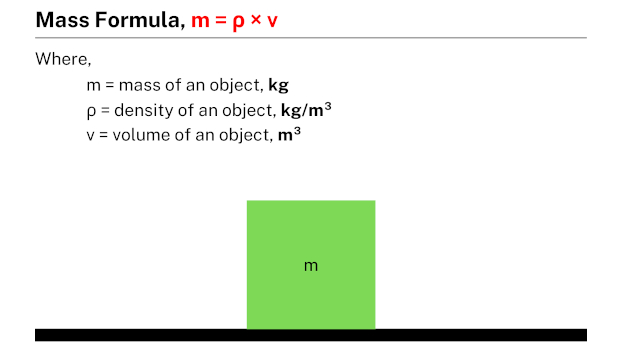
Mass quantifies the amount of matter an object possesses. It is an intrinsic characteristic of an object and remains constant regardless of its location. The kilogram (kg) serves as the standard unit of mass, commonly used to express the mass of different objects. For example, the mass of a textbook might be measured as 1.5 kilograms, while the mass of a car could be several thousand kilograms.
Examples
Everyday objects
| Book | 0.5 kg to 3 kg |
| Coffee cup | 0.2 kg to 0.4 kg |
| Mobile phone | 0.1 kg to 0.2 kg |
| Tennis ball | 0.057 kg to 0.058 kg |
| Flower petal | 0.04 kg to 0.08 kg |
| Pencil | 0.005 kg to 0.008 kg |
| Laptop | 1.5 kg to 2.5 kg |
| Golf ball | 1.5 kg to 2.5 kg |
| Cricket ball | 0.155 kg to 0.16 kg |
| Spoon | 0.025 kg to 0.03 kg |
| Soccer ball | 0.4 kg to 0.45 kg |
| DSLR camera | 1.5 kg to 2.5 kg |
| Wristwatch | 0.0005 kg to 0.0006 kg |
| Volleyball | 0.26 kg to 0.28 kg |
| TV remote | 0.07 kg to 0.14 kg |
Note: The mass values provided above for everyday objects are approximate and intended to give a general idea. Actual mass may vary depending on factors such as size, material composition, and specific product variations. For precise measurements, it is recommended to refer to product specifications or use appropriate measuring instruments.
Mass of planets
| Sun | 1.9891 × 1030 |
| Mercury | 3.285 × 1023 |
| Venus | 4.867 × 1024 |
| Earth | 5.972 × 1024 |
| Moon | 7.342 × 1022 |
| Mars | 6.39 × 1023 |
| Deimos (moon) | 1.4762 × 1015 |
| Phobos (moon) | 10.6 × 1015 |
| Jupiter | 1.898 × 1027 |
| Ganymede (moon) | 1.4819 × 1023 |
| Io (moon) | 8.94 × 1022 |
| Europa (moon) | 4.80 × 1022 |
| Callisto (moon) | 1.076 × 1023 |
| Saturn | 5.683 × 1026 |
| Titan (moon) | 1.345 × 1023 |
| Rhea (moon) | 2.306 × 1021 |
| Iapetus (moon) | 1.806 × 1021 |
| Dione (moon) | 1.095 × 1021 |
| Tethys (moon) | 6.174 × 1020 |
| Uranus | 8.681 × 1025 |
| Oberon (moon) | 3.076 × 1021 |
| Titania (moon) | 3.4 × 1021 |
| Umbriel (moon) | 1.275 × 1021 |
| Ariel (moon) | 1.27 × 1021 |
| Miranda (moon) | 6.4 × 1019 |
| Puck (moon) | 2.9 × 1018 |
| Neptune | 1.024 × 1026 |
| Triton (moon) | 2.139 × 1022 |
| Proteus (moon) | 4.4 × 1019 |
| Nereid (moon) | 3.1 × 1019 |
| Larissa (moon) | 4.2 × 1018 |
| Galatea (moon) | 2.12 × 1018 |
| Despina (moon) | 2.2 × 1018 |
| Pluto | 1.309 × 1022 |
Formula

The mass formula states that mass (m) is calculated as the product of an object’s density (ρ) and its volume (v). Mathematically, the formula for mass is expressed as m = ρ × v. This formula enables the calculation of the mass of an object based on its density and volume.
Practice problems
Problem #1
Calculate the mass of a steel object if the density of steel is 8050 kg/m3 and the volume of the object is 0.012 m3.
Solution
Given data:
- Mass of the object, m = ?
- Density of steel, ρ = 8050 kg/m3
- Volume of the object, v = 0.012 m3
Applying the formula:
- m = ρ × v
- m = 8050 × 0.012
- m = 96.6 kg
Therefore, the mass of a steel object is 96.6 kg.
Problem #2
If the density of a diamond is 3510 kg/m3 and the volume of the diamond is 0.005 m3, then calculate the mass of the diamond.
Solution
Given data:
- Density of a diamond, ρ = 3510 kg/m3
- Volume of a diamond, v = 0.005 m3
- Mass of a diamond, m = ?
Applying the formula:
- m = ρ × v
- m = 3510 × 0.005
- m = 17.55 kg
Therefore, the mass of a diamond is 17.55 kg.
Problem #3
The density of silver is 10497 kg/m3 and the volume of the silver object is 0.008 m3. Calculate the mass of the silver object.
Solution
Given data:
- Density of silver, ρ = 10497 kg/m3
- Volume of the object, v = 0.008 m3
- Mass of the object, m = ?
Applying the formula:
- m = ρ × v
- m = 10497 × 0.008
- m = 83.97 kg
Therefore, the mass of a silver is 83.97 kg.
Problem #4
Find the mass of a block of ice with a density of 917 kg/m3 and a volume of 0.007 m3.
Solution
Given data:
- Mass of ice block, m = ?
- Density of block, ρ = 917 kg/m3
- Volume of block, v = 0.007 m3
Applying the formula:
- m = ρ × v
- m = 917 × 0.007
- m = 6.41 kg
Therefore, the mass of an ice block is 6.41 kg.
More topics
External links
- Examples of Mass – YourDictionary
- What is Mass? | Definition, Formula & Units – Study.com
- Mass in Math – Definition with Examples – SplashLearn
- Mass – Wikipedia
- What’s an example of mass? – Quora
- Examples of ‘mass’ in a sentence – Collins Dictionary
- Mass Definition & Meaning – Merriam-Webster
- Mass and Weight – Ducksters
- Mass Examples – SoftSchools.com
- How to Calculate Mass: 10 Steps (with Pictures) – wikiHow
- What Is Mass ⭐ Definition with Examples – Brighterly
- Mass, Weight, Density – HyperPhysics Concepts
- Mass Calculator – Calculator.net
Deep
Learnool.com was founded by Deep Rana, who is a mechanical engineer by profession and a blogger by passion. He has a good conceptual knowledge on different educational topics and he provides the same on this website. He loves to learn something new everyday and believes that the best utilization of free time is developing a new skill.
